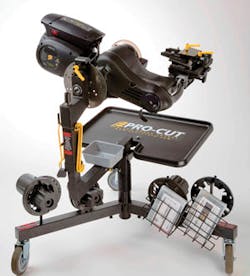Before rubber can hit the road, those wheels need something to attach to. Brake lathes allow techs to properly care for a customer’s rotors or drums, help prevent uneven wear of pads and keep a vehicle stopping smoothly.
According to Greg Meyer, product manager of brake lathes and wheel balancers for Hunter Engineering, brake lathes have two purposes: to reduce lateral runout (seen when a wheel wobbles or shimmies), and to prevent variation thickness.
“The thickness variation is of the most immediate concern, because if you think about the brake pads that are clamping (the rotor) like a vice on both sides. If that rotor gets thicker as it’s passing through that, essentially that will increase the braking force. As the rotor starts to get thinner, suddenly you’re going to be not braking as hard as you were,” explained Meyer. “That will cause that pedal pulsation, a vibration, as you were braking.
“Think about that vise clamp that’s grabbing those rotors. That vise clamp is getting knocked back and forth. It’s going to get pushed from the left to the right, which is fine … but what that’s doing is causing uneven wear, that will eventually lead to a thickness variation, which would get you back to your pedal pulsation again. It’s today’s problem versus tomorrow’s problem,” said Meyer.
The first step to providing the right equipment is determining what kind of brake lathe is right for the shop.
ON-CAR VS. BENCH LATHES
There are two main types of brake lathes: on-car and bench. The difference is where the action takes place.
“On the bench lathes you’re removing the rotor, and then you’re taking that rotor and … using an arbor to clamp it up to the bench lathe,” said Meyer. “In the on-car lathe, you’re bringing the machine to the vehicle, so you don’t have to remove the rotors from the vehicle.”
Using bench lathes can be more time-consuming, not only with initial prep, but also the number of cuts to the rotor.
“In bench lathes, generally they will recommend a rough cut and then the clean cut, and then a finished pass. You can also do a single cut as well on a bench lathe, but the chatter control is more of an issue on bench lathes than it is on the on-car lathes,” said Meyer. (Additional accessories are available to eliminate that concern.)
You’ll find on-car lathes more often at larger shops and dealerships, not just because they’re faster and more efficient, but because many manufacturers require on-car lathes for warranty purposes. Because the wheel and rotor never leave the actual vehicle, techs have less room for error when cutting.
Meyer explains the concern with bench lathes:
“When you pull a rotor off of the vehicle, you may have turned it perfectly off the vehicle and then you install it back on the vehicle. Because it wasn’t installed the same way, you could unknowingly induce run out. You will, in essence, have undone some of your efforts.”
Although on-car lathes seem like the sure-fire bet for shops, some applications require a bench lathe, including at heavy-duty shops.
Also, any type of drum brake work needs to be done off the car. Meyer explains two reasons why.
“One is the design. That’s actually enough of a reason in and of itself. There’s no way to get inside around that drum because it’s a sealed unit. Whereas discs are open, essentially they’re exposed,” he said. “Also, the drum brakes are much less sensitive to run out than disc brakes are.”
Trends show that shops continue to work on disc brakes much more often than drum brakes.
“Basically, drum (brakes) are only used on the rear of some vehicles now. They’re never used on the fronts anymore; and 75 percent or better of your stopping power is at the front of your vehicle,” said Geoff Womer, product manager for Pro-Cut International. “Most of your brake jobs… almost two-to-one will be front brake jobs. Since all front brakes are rotors, they’re mostly going to be disc brake jobs.
“Any kind of car that has any kind of performance at all, and even many trucks now, use discs in the rear as well,” he said.
“Power and torque are important for on-car lathes, to be able to turn the wheels through driveline friction, because the alternative is that you have to go and drop driveshafts,” said Meyer. “If you can’t turn a wheel, your only alternative, if there’s too much torque required to turn the wheel to turn the brake, you have to disconnect the drive shaft to allow the other side to spin more freely, and I think that’s a very labor-intensive operation, so you want to avoid that at all costs.”
THE DIGITAL REVOLUTION
Regardless of differences between the lathe types, some models of both on-car and bench lathes are capable of working digitally, with computerized compensation to remove run-out. Womer said that advancing technology has helped some shops convert to fully computerized compensation.
“The machine self-compensates once you hook the adapter up to the hub, put the machine up to the adapter, and attach the machine to the adapter,” said Womer. “You start the machine, push one button, and in about 30 seconds the machine has compensated for lateral run out.”
Many manufacturers require records of the length of cut, for warranty reasons. With digital displays, users are able to record these numbers for reference, said Womer.
Along with meeting OE requirements, this feature takes the guesswork out of tweaking cuts so techs don’t have to be as familiar with the fine-tuned aspects of using a lathe manually.
MORE FEATURES
• Limiting the number of tools needed for capital equipment operation is a benefit to any shop. According to Womer, who described a particular model, 9.2 PRO that offers more efficient operation, “the actual setup of the machines requires no tools, because everything’s knobs, levers and buttons.”
• Some lathes also offer anti-chatter devices for a quieter cut. This feature helps users avoid the resonance that occurs when cutting the rotor, similar to the high-pitch frequency heard when running a finger around a crystal glass. “(Anti-chatter Control Technology) automatically varies the speed in which it’s cutting, up and down, and that prevents that resonance from taking place. It’ll give you better surface finish, and a more accurate cut,” said Meyer.
• Another feature some shops look for is an intermittent cutting pattern. “The cutting head, just starting in the middle and moving its way outward, actually stops and has an intermittent cutting pattern. So it moves and stops, moves and stops, as it slowly migrates to the outside of the rotor. That improves surface finish, and eliminates that continuous feed cut,” said Meyer.
This cutting helps vehicles retain the brake pad surface for longer wear.
In this economy, as shops are looking everywhere they can increase tickets, many owners will look to expand services. Once the domain of mainly specialists, with the advance of brake lathes, many shops will be able to add brake service to their credentials and you can be ready to answer equipment questions.



